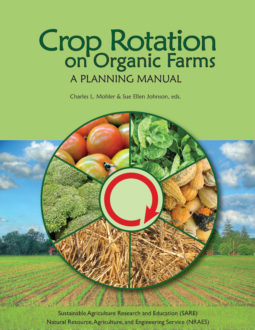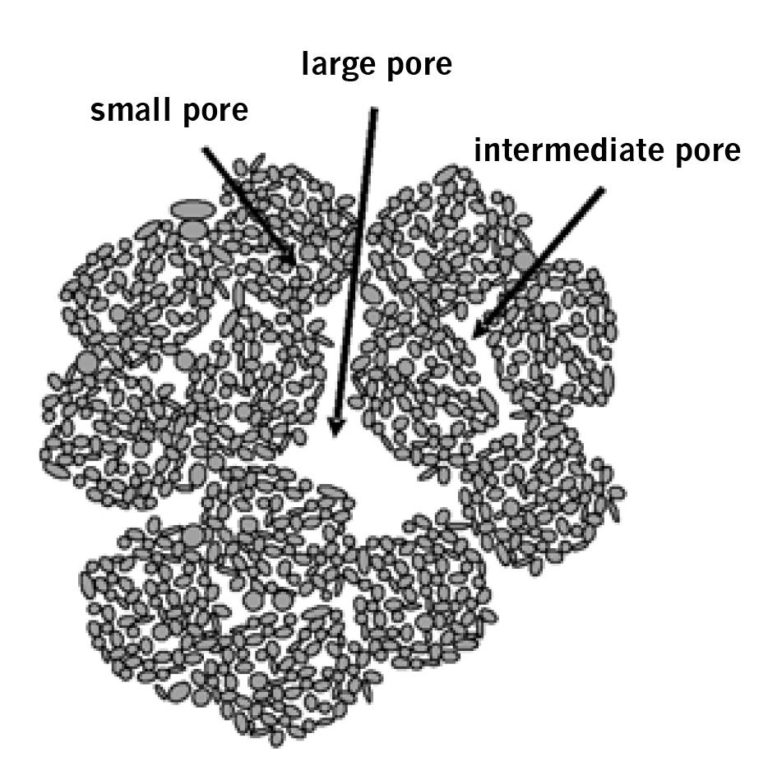
Tilth generally refers to the physical condition of the soil as it relates to plant growth. Favorable tilth implies good conditions for seed germination and root proliferation, allowing crops to thrive. Also, a soil with good tilth facilitates other processes, such as water infiltration and aeration, which benefit both crop and environment. Good soil tilth is usually equated with aggregation (presence of soil crumbs), because stable aggregates promote these favorable processes. Crop rotations can have a positive impact on soil tilth, depending on the crops that are being alternated. Additional ways to improve soil tilth include reducing tillage and using cover crops. There are thus a number of approaches to improving the physical quality of the soil, and often a combined approach produces the greatest improvement.
Soil Tilth and Aggregation
Figure 3.3 shows a soil aggregate, or crumb, found in a soil of good tilth. With finer-textured soils, such aggregates may in turn be made up of smaller ones that are clumped together. The aggregates themselves are perhaps less important than the spaces (or pores) between them, and a soil that is well aggregated also has a range of pore sizes. Each pore size plays a critical role in the physical functioning of the soil. Large pores drain rapidly and are needed for good air exchange during wet periods. This prevents oxygen deficiency in the soil, which stresses most crop types, sometimes to the point of death. Oxygen deficiency also increases pest problems. Denitrification (conversion of nitrogen to gaseous forms) is another concern with oxygen-deficient waterlogged soil. Denitrification results in rapid and significant loss of soil nitrogen and generates nitrous oxide, a potent greenhouse gas. When soil becomes degraded, either through long-term intensive cultivation and erosion or through compaction from traffic, it loses its aggregation, and the large pores are compressed into small ones. Coarse-textured sands and gravels naturally have large pores, and therefore are less dependent on aggregation to provide good tilth and aeration. Finer-textured soils, however, depend heavily on aggregates for good physical structure and tilth and, once degraded, become structureless, dense, and hard.
A mix of large and small pores is desirable. Small pores are critical for water retention and help a crop go through dry periods with minimal yield loss. Sandy and gravelly soils are naturally deficient in small pores and are therefore drought prone, whereas loams and clays can retain and thus supply crops with more water.
Good soil management and rotations can increase crop water availability if they increase the soil’s organic matter content, which is an important contributor to water retention. Coarse-textured soils can thus also benefit from good management, even though they are less dependent on aggregation.
Good soil tilth can be obtained through mechanical and biological manipulation of the soil. Mechanical soil cultivation practices, including primary tillage (mold-board or chisel plowing) followed by secondary tillage (disking, harrowing, etc.), have the aim of producing a good seedbed. When soils become degraded and compacted, such tillage practices are often deemed necessary to establish a good crop, because the soil would otherwise be too dense, hard, or cloddy. The tilth created by tillage, however, tends to be unstable, because the aggregation is obtained through the physical manipulation of the soil, which is short lived, especially after many years of intensive tillage. Aggregates in such soils will readily fall apart during subsequent rains, causing the soil to settle and become dense and hard. This then generates a vicious cycle in which the soil needs to be intensively tilled each year to provide good seedbed conditions, which in turn makes the problem worse. Such a soil may be considered “addicted to tillage.”
The preferred scenario is for the aggregates and good tilth to be the result of natural soil building processes, such as the activity of plant roots, earthworms, and other beneficial organisms. Such stable aggregates will break apart during tillage or planting and therefore readily provide good tilth, as opposed to unstable, weakly aggregated soil, which tills up cloddy. Also, stable aggregates are held together by organic bonding materials that resist breakdown during soil saturation and heavy rainfall. These organic materials are themselves subject to biological degradation, so there needs to be a continual effort to “feed the soil” with organic material, and to minimize organic matter breakdown from intensive tillage.
Aggregation in the Subsoil
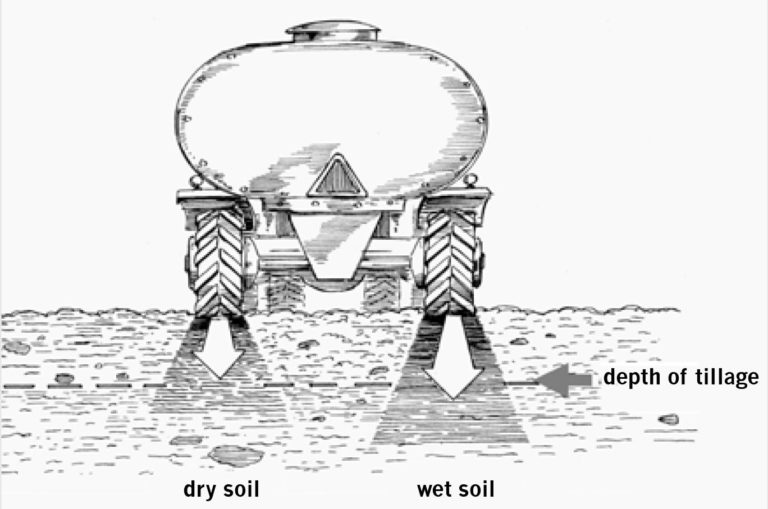
People tend to focus on soil tilth in the plow layer, but good aggregation is also important in the subsoil, the layer below the regular depth of tillage. Such aggregates are generally not crumb-like but involve larger (2- to 6-inch) blocks of soil that are more angular and not as distinctive. These aggregates are less impacted by biological activity of microbes, earthworms, and roots than the crumbs in the surface layer. Subsurface aggregates are important for root growth deep into the profile. Deep roots allow a plant greater access to soil moisture, which helps it through drought periods. Aggregates below the surface layer can also be compacted. The main cause for this is heavy equipment loads on wet soil (figure 3.4), where the force of compaction is transferred deep into the soil, beyond the plow layer. Another significant source of subsoil compaction is the practice of plowing with a set of wheels in the open furrow. This way the subsoil is directly loaded by the tractor tires.
Soil Hardness
Soils generally become harder when they dry. There is a difference, however, between well-aggregated and compacted soil, in that the latter becomes hard more readily upon drying (figure 3.5). This causes problems with crop emergence, root restriction, and reduced plant growth. A scenario that is often observed is the hardsetting of poorly aggregated (low organic matter) soil when tillage is followed by large amounts of rainfall. The aggregates forming the loose tilth after tillage are not stable and fall apart when the soil becomes saturated. The soil then settles and becomes hard. If the aggregates are stable as a result of good management and adequate organic matter, they will hold up against the rain, and good tilth will be preserved.
Similarly, compacted subsoils become hard and impenetrable to roots when they dry. Rotation with cover crops that grow aggressively in the early and late growing season are thus better able to penetrate plow pans and hard subsoil, because the soil is then moist and sufficiently soft for root penetration. In contrast, a summer annual, like corn, does not see significant root growth until the late spring, when compacted soils may already have become dry and hard.
"Rotation with cover crops that grow aggressively in the early and late growing season are ... able to penetrate plow pans and hard subsoil, because the soil is then moist and sufficiently soft for root penetration."
Effects of Rotation Crops
Rotation crops can help build soils, as illustrated in figure 3.6. Studies have shown that organic matter losses from intensively tilled row crops can be regained when the field is rotated into a perennial sod crop. There are two processes that contribute to this gain. First, the rapid rate of organic matter decomposition from tillage is stopped under the sod crop. This benefit, of course, is also gained when a no-tillage cropping system is employed. Second, grass and legume sods develop extensive root systems that continually grow and die off. The dead roots supply a source of fresh, active organic matter to the soil, which feeds soil organisms that are involved in building soil aggregation. Earthworms and many other beneficial organisms need continual supplies of organic matter to sustain themselves, and they deposit the digested materials on soil aggregates and thereby stabilize them. Also, the living roots and symbiotic microorganisms (for example, mycorrhizal fungi) can exude organic materials that nourish soil organisms and help with aggregation. Grass and legume sod crops therefore return more organic matter to the soil than most other crops.
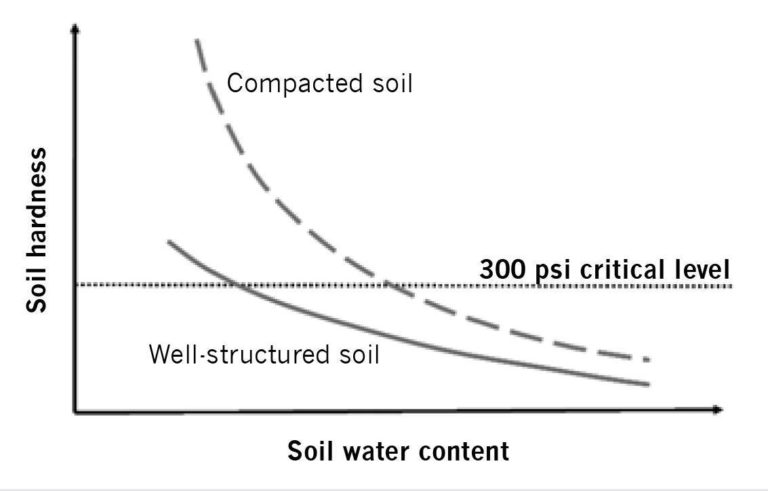
Sod crops appear to be the most effective in building good soil tilth in the surface layer. The dense, fibrous, rooting system of perennial grasses and shallow-rooted legumes creates a very active biological zone near the surface. If a short rotation is used, and tillage is minimized, the benefits of the sod crop are enhanced. Hay or pasture fields can be established with minimal tillage if a good no-till drill is used and weed pressure is low. Some annual rotation crops such as buckwheat also have dense, fibrous, root systems and can improve soil tilth. Sometimes, compatible mixtures of crops are beneficial because they have different rooting systems. For example, red clover seeded into winter wheat provides additional roots and a more protein-rich source of organic matter.
Other rotation crops are less effective in building tilth in the surface layer but are more valuable for improving dense subsoils. Some perennial crops, such as alfalfa, have strong, deep, penetrating tap roots that can push through hard layers, especially during wet periods when the soil is soft. These deep roots make pathways for water and future plant roots, and bring organic matter into the subsoil.
Crops can be beneficial in a rotation if they extend the period of active growth compared to conventional row crops. For example, in a corn-soybean rotation, active growth occurs only 32 percent of the time, while in a dry bean–winter wheat–corn rotation, this period is 72 percent (14). This provides longer periods of soil cover, thereby reducing erosion potential and loss of good topsoil. Also, it provides longer periods in which active roots feed the soil. Some crops such as rye, wheat, oat, barley, pea, and cool-season grasses grow actively in the late fall and early spring and thereby can help build stable soil tilth. They are beneficial both as rotation and cover crops, but the positive effects may be negated if intensive tillage is used to establish them.
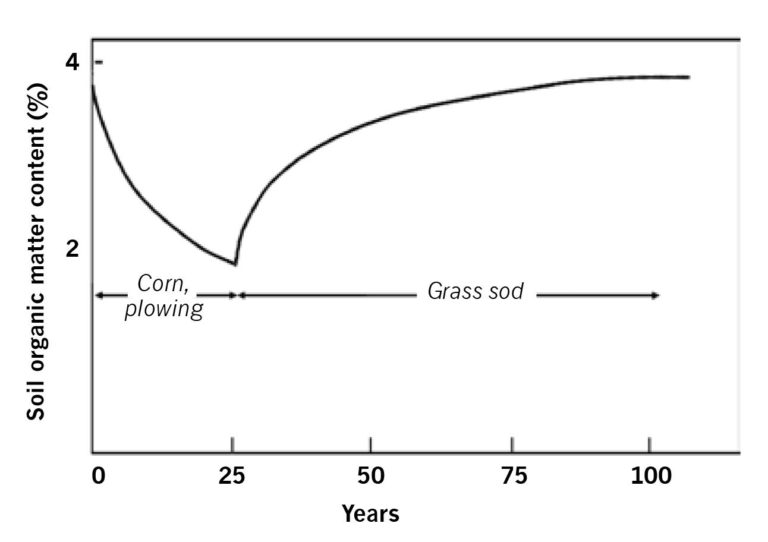
In summary, rotations provide opportunities for improving soil physical quality, especially if the active growth period is expanded and the amount of tillage in the rotation is reduced. With careful selection, rotation crops can be targeted to help alleviate certain soil quality problems. A densely rooted sod crop helps build tilth in the plow layer, while a deep-rooted crop helps address problems with subsoil compaction. In many cases, the rotation should include a mixture of crop types to increase the diversity of organic matter that supports soil-building organisms, and to address multiple soil quality objectives.
A grower should consider a field assessment to identify problems and better tailor the rotation to the needs of the soil. This may include an assessment of soil tilth in the surface layer, rooting depth, and soil hardness in the subsoil. A soil penetrometer is a useful tool for this, but digging with a shovel is perhaps the most instructive. The Cornell Soil Health Test has recently been developed to provide an integrated assessment of soil quality through chemical, biological, and physical indicators. This includes aggregate stability, an indicator of soil tilth. For further information on the test and management practices that promote soil health, visit Cornell Soil Health.
